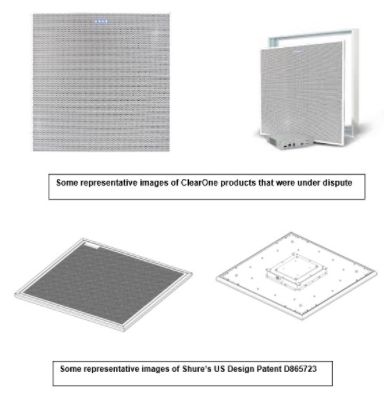- within Real Estate and Construction, Media, Telecoms, IT, Entertainment and Finance and Banking topic(s)
- with readers working within the Law Firm industries
Recently, ClearOne, a Salt Lake City, US-based global provider of audio and visual communication solutions announced that a jury in the U.S. District Court for the District of Delaware returned a verdict of no infringement by ClearOne's Ceiling Tile Beamforming Mic Array product line on Shure Incorporated's U.S. Design Patent No. D865,723 (the "'723 patent"). The jury also declared the "'723 patent" to be invalid.
ClearOne is a company that designs, develops, and sells conferencing, collaboration, and network streaming solutions for voice and visual communications while Shure Incorporated too is a US-based microphone and audio electronic equipment manufacturer.
In the case (Shure Incorporated, and Shure Acquisition Holdings, Inc., v. Clearone, Inc.; Civil Action 19-1343-RGA) Shure accused ClearOne of infringement on its BMA CT, Versa Pro CT, COLLABORATE Versa Lite CT, COLLABORATE Versa Room CT), BMA 360 and BMA-CTX ("Xceed") products.

The jury decided ClearOne didn't infringe Shure Inc.'s U.S. Patent No. D865,723, covering a ceiling array microphone. Jurors in the U.S. District Court for the District of Delaware also found Shure's design patent to be invalid.
It is well established that only non-functional aspects of the design are considered in the infringement analysis. In this case, it was found that the "square shape of the claimed design" be functional. Therefore, Shure cannot advance infringement arguments based on the square shape of the array microphone assembly. The Magistrate Judge strikes portions of Shure's expert report that reference the outermost square shape. The Magistrate Judge goes on to distinguish the portions of Mr. Hatch's expert report that reference the "outermost square shape" and the other square elements of the design that are not dictated by functionality. This is a tenable distinction. The functional aspect of the square shape is in the ability to replace a standard, square, ceiling tile with the claimed array. The other square elements, including the face of the array, were a design choice and thus entitled to protection. ClearOne also argued is that there are obvious differences on the back panel of the claimed design and the accused products and the court too agreed that the back panel must be considered in the infringement analysis, even if it is concealed for most of the product's lifespan.
ClearOne's existing lawsuit against Shure also alleges that Shure, itself and jointly with others, infringes ClearOne's U.S. Patent No. 9,635,186 ("the '186 Patent"). Although Shure recently added the claim that the '186 Patent was unenforceable, ClearOne rejects this claim and will vigorously defend the '186 Patent and prosecute Shure's infringement.
ClearOne Wins Design Patent Infringement Suit
The content of this article is intended to provide a general guide to the subject matter. Specialist advice should be sought about your specific circumstances.

